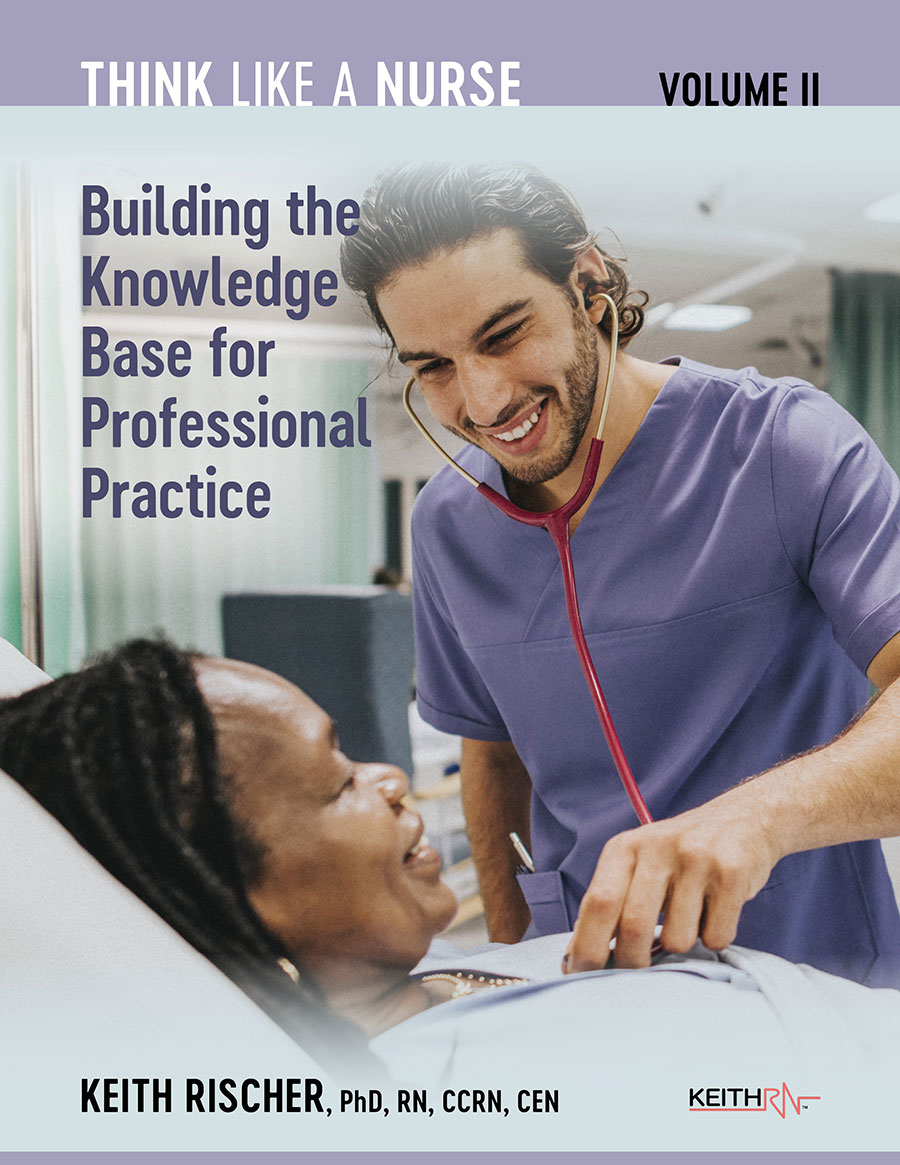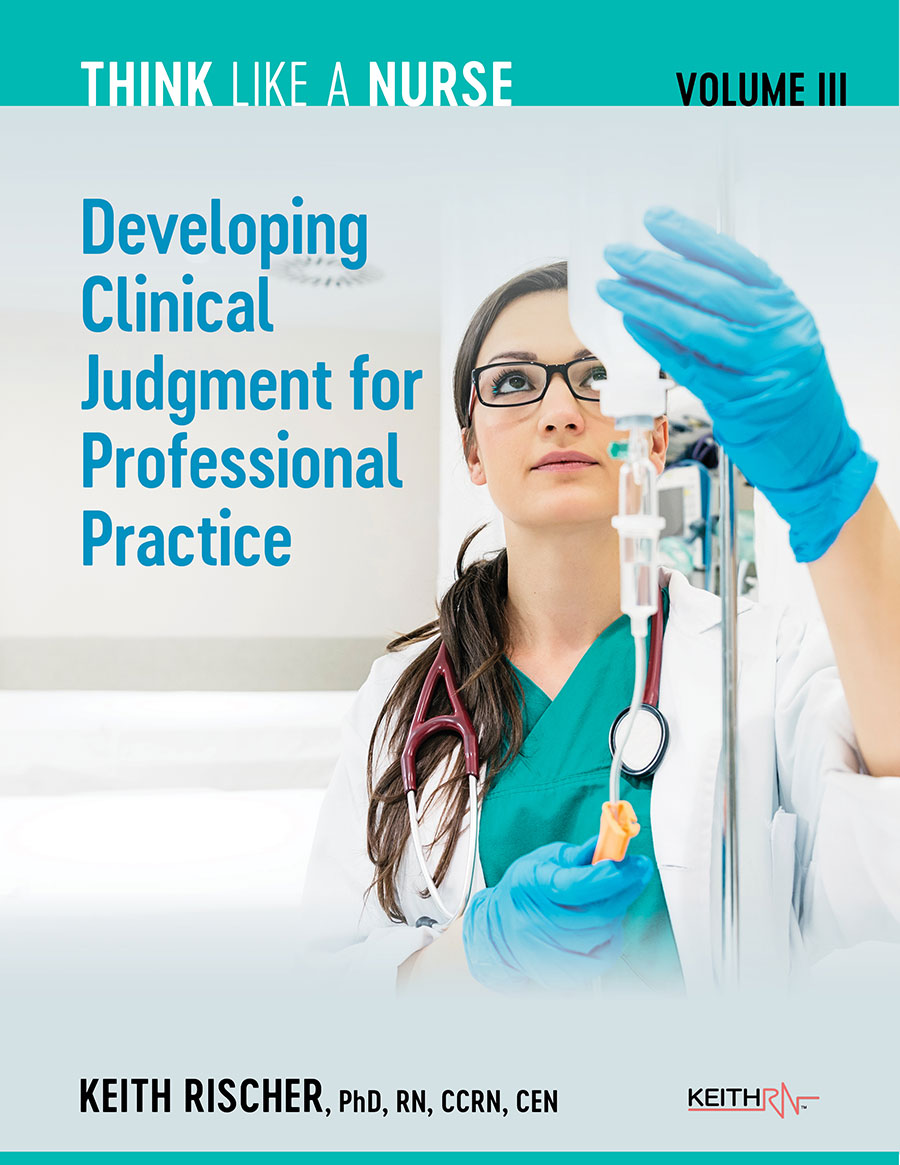
With declining clinical hours, increasing patient complexity, and too much information in the curriculum, nursing students struggle to understand what is most important for safe patient care.
As a result, nurses graduating with entry-level clinical judgment skills has declined from 23% in 2017 to only 9% today.
This crisis in competency can result in adverse and potentially disastrous patient outcomes.
Students and new nurses need to learn a holistic approach to develop clinical judgment and prepare for safe practice. This comprehensive approach begins by emphasizing the 3 C’s: CARING, CRITICAL THINKING, and CLINICAL REASONING.

Keith Rischer, Ph.D., RN, CCRN, CEN
As a nurse with over 35 years of experience who remained in practice as an educator, I’ve witnessed the gap between how nursing is taught and how it is practiced, and I decided to do something about it!
I launched KeithRN in 2012 to improve the practice-readiness of students by creating innovative case studies that help students practice clinical judgment skills.
Since then, thousands of educators and students have successfully used my unfolding case studies and best-practice strategies to practice and develop clinical judgment.
Each volume of Think Like a Nurse presents foundational knowledge that builds from one book to the next.
Content is introduced, defined, and reinforced with clinical-based activities and practical guidance from practicing nurses.
Prepare students for practice and Next Generation NCLEX, with active learning that relates concepts to case studies from clinical practice.

Students learn how to develop grit and practice study and test-taking strategies to improve their success, how to provide authentic holistic patient care, and how to establish a professional identity so they can start to think, feel, and act like a professional nurse.

Students review the essential knowledge of the applied sciences to develop critical thinking. Before knowledge can be used, it must first be understood. Application activities help students understand and relate this content to clinical practice.

Students learn the steps of clinical reasoning: identifying the most important patient data, determining that data’s significance, recognizing and prioritizing problems, and setting nursing priorities—all supporting the effective development of sound clinical judgment.
To find out how the textbook series can be integrated across the curriculum, view this informative guide! Learn more about textbook adoption for your course/program.
Keith Rischer, PhD, RN, CCRN, CEN
Introduction: Building Your House of Professional Nursing Practice
Chapter 1: Personal Foundations for Nursing: Intelligence Is Great, but Grit Will Get You Through
Chapter 2: Student Life: Don’t Just Survive—Thrive!
Chapter 3: Academic Success: Strategies for Optimum Academic Results
Chapter 4: Holistic Care: The Foundational Art of Nursing
Chapter 5: Developing Your Professional Identity
Chapter 6: Choosing Civility: Steps to Restore Wounded Caregivers and the Nursing Profession
A. Core Aptitudes and Traits for Nurses: Pre-nursing Self-Assessment
B. Core Aptitudes and Traits for Nurses: Reflection Guide
C. The Nightingale Pledge
D. A Nurse’s Prayer
Keith Rischer, PhD, RN, CCRN, CEN
Introduction: What Do You Need to Know to Think Like a Nurse?
Appendix A: Pathophysiology Activities
I. Pathophysiology Review Activity
II. Care Planning Activity
III. Pathophysiology Critical Thinking Activity
IV. What Problem Came First? Activity
Appendix B: Pathophysiology Worksheets
I. Pathophysiology Review Worksheet
II. Care Planning Worksheet
III. Pathophysiology Critical Thinking Worksheet
IV. What Problem Came First? Worksheet
Appendix C: Pharmacology Activities
I. Patterns of Pharmacology Activity
II. Pharmacology Classes Activity
III. Pharmacology Made Practical Activity
Appendix D: Pharmacology Worksheets
I. Patterns of Pharmacology Worksheet
II. Pharmacology Classes Worksheet
III. Pharmacology Made Practical Worksheet
Appendix E: Lab Values Review Worksheet
Appendix F: Connecting the Sciences Worksheet
Keith Rischer, PhD, RN, CCRN, CEN
Introduction: What Does It Take to Think Like a Nurse?
Epilogue: Make a Difference
A. Preparing for NCLEX and Next Generation NCLEX
B. The Nightingale Pledge
C. A Nurse’s Prayer
Download a free excerpt and activity from Volume I, plus receive additional excerpts from Volume II and III.
Sign up today and you will also be first in line to get prepublication discounts!
Get all three textbooks and see how you and your students can benefit from this unique resource as a textbook for program adoption.
These concise, integrated resources emphasize a practice-based approach so students can immediately apply what they’ve learned. Educators are then empowered to focus on developing students’ clinical judgment.
Clinical Reasoning Case Studies engage students by allowing them to practice what they’ve learned and develop the critical thinking and clinical judgment skills used in practice.
Each book uses a variety of interactive learning tools, including case studies, worksheets, and quick reference guides with opportunities to pause, reflect, engage in the content, and jot ideas in the margins. Students retain the knowledge gained and develop deep understanding apply at the bedside where it matters most!
Students need more than NextGen NCLEX questions to review to develop clinical judgment. Each volume is a comprehensive resource written in an easy-to-read, mentoring tone that will remain relevant through nursing school and into practice.